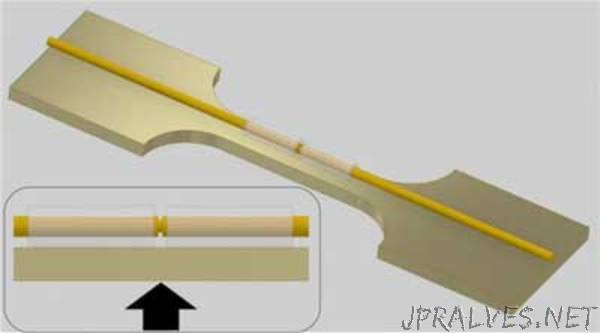
“Scientists at Aix-Marseille University developed a stable mechanical design to measure electrical current across a single molecule that assembles on a noble metal at room temperature.
When noble metals, like gold, are treated with an aliphatic thiol, like alkanethiol, a uniform monolayer — a layer only one molecule deep — self-assembles on the surface. Each individual molecule can conduct electrons. This phenomenon is interesting because the conducting molecules produce unique quantum properties that could potentially be useful in electronics such as transistors, superconducting switches and gas sensors.
Attempts to measure the current across this thin skim of molecules have yielded varied results. Researchers at Aix-Marseille University in France developed a new, stable mechanical setup to measure conductance across individual molecules with greater success. The results are published in the Journal of Applied Physics, from AIP Publishing.
“This is really a fundamental study concerning the behavior of one or a few molecules,” said Hubert Klein, assistant professor at Aix-Marseille University and a co-author on the paper. “The results provide some fresh ideas to people interested in its applications in electronic devices.”
Previous studies explored Scanning Tunneling Microscopy and Break Junction techniques to measure electrical conductance through individual molecules. These previous studies highlighted the importance of temperature on conductance across the molecular layer. Due to limitations in experimental conditions, the results from both techniques produced a large spread in the current measured.
Klein and his team developed a new technique that builds on this observation. Their mechanical setup consists of a notched alkanethiol-treated gold wire attached to a phosphorous bronze bending plate. At room temperature, the molecules self-organize on the gold wire.
According to Klein, the design for this study resulted from a previous project that produced picometer resolution and required a stable setup to ensure electrodes did not drift at room temperature. At the same time, he continued his studies of single molecule observations using near field microscopy techniques.
“We thus naturally had the idea to apply our new custom device to questions of single molecule conductance,” Klein said.
Using this new setup, the team was able to measure the spontaneous evolution of current at the notch along the gold wire between two metallic electrodes. The team determined conductance across an individual molecule by measuring current jumps from the spontaneous connection and de-connection of molecules in contact with the electrodes. Temperature drove “temporal evolution” when mechanical strain wasn’t acting on the molecule.
The researchers acknowledge that the mechanical design in this study is not necessarily achievable under standard laboratory conditions. However, the stability of this new approach opens opportunities for new studies on nanocontacts, and the dynamics and transport of molecules at room temperature.
“It’s exciting to see that we have access to the behavior of individual nanometric objects at room temperature,” Klein said. “It’s a great reward to see the efforts of your intuition become a reality.”
The project received funding from the Agence Nationale de la Recherche.”
